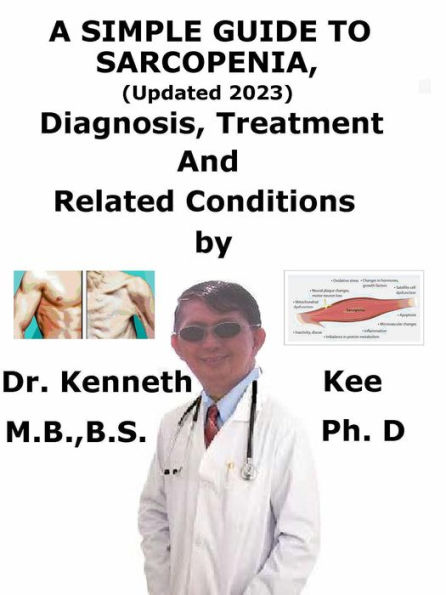
A Simple Guide to Sarcopenia, (Updated 2023) Diagnosis, Treatment and Related Conditions

A Simple Guide to Sarcopenia, (Updated 2023) Diagnosis, Treatment and Related Conditions
Overview
Sarcopenia is a medical disorder known as age-related sarcopenia or sarcopenia with aging which starts in the 30s when a person starts to lose muscle mass and function.
Sarcopenia (from Greek sarx,"flesh" and penia,"poverty") is the degenerative loss of the skeletal muscle mass (0.5–1% decrease per year after the age of 50), quality, and strength linked with aging.
Sarcopenia is a part of the frailty syndrome.
Sarcopenia may occur in healthy people and does not necessarily involve malaise.
People who are physically not active can lose as much as 3% to 5% of the muscle mass every decade after age 30.
Even if the person is active, he or she will still experience some muscle reduction.
Any reduction of muscle mass requires reduction of strength and mobility.
Sarcopenia typically becomes worse at the age of 75 although it may occur in people age 65 or 80
It is a factor in the production of frailty and affect the tendency of falls and fractures in older adults.
Sarcopenia is believed to be caused by a failure in activation of satellite cell around muscle cells.
Extreme muscle loss is frequently a result of both decreasing anabolic signals, including growth hormone and testosterone, and promotion of catabolic signals, such as pro-inflammatory cytokines
Sarcopenia is characterized by:
1. A muscle atrophy (a decrease in the size of the muscle),
2. A reduction in muscle tissue quality
Symptoms of muscle loss are:
1. Musculoskeletal weakness
2. Loss of stamina,
3. Reduced physical activity
The primary treatment for sarcopenia is exercise.
In particular, the exercise resistance training or strength training (exercise that increases muscle strength and endurance with the use of resistance bands or weights) has been observed to be helpful for both the prevention and treatment of sarcopenia.
Testosterone or other forms of anabolic steroids seem to have some positive effects on muscle strength and mass.
TABLE OF CONTENT
Introduction
Chapter 1 Sarcopenia
Chapter 2 Causes
Chapter 3 Symptoms
Chapter 4 Diagnosis
Chapter 5 Treatment
Chapter 6 Prognosis
Chapter 7 Muscle Dystrophy
Chapter 8 Cerebral Palsy
Epilogue

Product Details
| BN ID: | 2940153786452 |
|---|---|
| Publisher: | Kenneth Kee |
| Publication date: | 10/17/2016 |
| Sold by: | Smashwords |
| Format: | eBook |
| File size: | 569 KB |
About the Author
Medical doctor since 1972.
Started Kee Clinic in 1974 at 15 Holland Dr #03-102, relocated to 36 Holland Dr #01-10 in 2009.
Did my M.Sc (Health Management ) in 1991 and Ph.D (Healthcare Administration) in 1993.
Dr Kenneth Kee is still working as a family doctor at the age of 74
However he has reduced his consultation hours to 3 hours in the morning and 2 hours in
the afternoon.
He first started writing free blogs on medical disorders seen in the clinic in 2007 on http://kennethkee.blogspot.com.
His purpose in writing these simple guides was for the health education of his patients which is also his dissertation for his Ph.D (Healthcare Administration). He then wrote an autobiography account of his journey as a medical student to family doctor on his other blog http://afamilydoctorstale.blogspot.com
This autobiography account “A Family Doctor’s Tale” was combined with his early “A Simple Guide to Medical Disorders” into a new Wordpress Blog “A Family Doctor’s Tale” on http://ken-med.com.
From which many free articles from the blog was taken and put together into 1000 eBooks.
He apologized for typos and spelling mistakes in his earlier books.
He will endeavor to improve the writing in futures.
Some people have complained that the simple guides are too simple.
For their information they are made simple in order to educate the patients.
The later books go into more details of medical disorders.
He has published 1000 eBooks on various subjects on health, 1 autobiography of his medical journey, another on the autobiography of a Cancer survivor, 2 children stories and one how to study for his nephew and grand-daughter.
The purpose of these simple guides is to educate patient on health disorders and not meant as textbooks.
He does not do any night duty since 2000 ever since Dr Tan had his second stroke.
His clinic is now relocated to the Buona Vista Community Centre.
The 2 units of his original clinic are being demolished to make way for a new Shopping Mall.
He is now doing some blogging and internet surfing (bulletin boards since the 1980's) starting
with the Apple computer and going to PC.
The entire PC is upgraded by himself from XT to the present Pentium duo core.
The present Intel i7 CPU is out of reach at the moment because the CPU is still expensive.
He is also into DIY changing his own toilet cistern and other electric appliance.
His hunger for knowledge has not abated and he is a lifelong learner.
The children have all grown up and there are 2 grandchildren who are even more technically advanced than the grandfather where mobile phones are concerned.
This book is taken from some of the many articles in his blog (now with 740 posts) A Family Doctor’s Tale.
Dr Kee is the author of:
"A Family Doctor's Tale"
"Life Lessons Learned From The Study And Practice Of Medicine"
"Case Notes From A Family Doctor"
